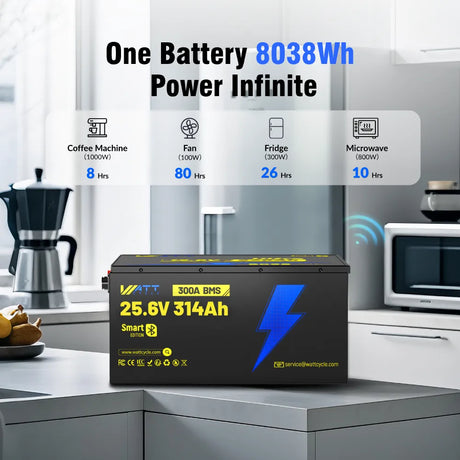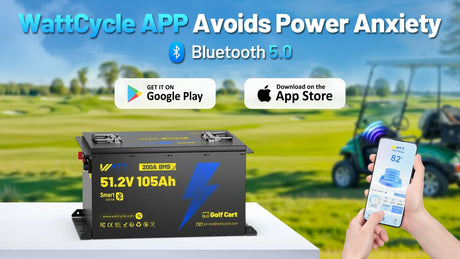If you’ve ever outfitted an RV, boat, or off-grid cabin with a LiFePO4 battery bank, you know how critical the right lithium battery charger is to keep your lights on and your devices humming. Mixing voltages—like trying to use a 24 V LiFePO4 battery charger on a single 12 V battery—isn’t as simple as plugging in and powering up. A mismatched charger can lead to BMS cut-offs, heat buildup, or even permanent cell wear, turning a smooth adventure into an unexpected roadside repair.
Here’s the bottom line: a charger designed for 24 V output won’t properly fill a 12 V pack. Even if you force the connection, the over-voltage risk and BMS protections in your 12 V LiFePO4 battery will shut down charging long before your cells reach full capacity. In the next sections, we’ll explain exactly why this happens—and how to choose the right LiFePO4 battery charger for your setup.
What “24 V” vs. “12 V” Really Means
At its core, “12 V” or “24 V” describes the nominal voltage of your battery pack—the average electrical potential its cells deliver under normal load. In contrast, the charging voltage is the peak pressure your lithium battery charger applies during the absorption stage (around 14.4 V–14.6 V for a 12 V pack, and roughly 28.8 V–29.4 V for a 24 V pack). If you hook up a 24 V charger to a 12 V battery, the charger will try to push far more voltage than the pack is designed to accept, immediately triggering BMS cut-offs or risking over-voltage stress.
LiFePO4 chemistry demands this precise electrical “pressure” because its cells balance voltage in tight 0.01 V increments to protect cycle life and capacity. Too little voltage leaves cells undercharged, while too much can generate heat, unbalance cell groups, and shorten battery lifespan. That’s why choosing the right LiFePO4 battery charger—one matched exactly to your pack’s nominal voltage—is the first step in safeguarding performance and safety.
Can a 24 V Lithium Battery Charger Top Up a 12 V Battery?
No—you can’t use a 24 V LiFePO4 battery charger to charge 12 V battery safely. Pushing 28.8 V–29.4 V of charging voltage into a 12 V pack instantly trips the BMS over-voltage protection, and any attempt to override it risks heat buildup, cell imbalance, and may void your charger or battery warranty.
Curious about the flip side? Once you’ve seen why a 24 V charger can’t fully fill a 12 V pack, dive into our article on whether a 12 V lithium battery charger can ever charge a 24 V battery, and what happens if you try!
Risks of Over-voltage on a 12 V LiFePO4 Battery
When a 24 V charger tries to force its higher voltage into your 12 V LiFePO4 battery, several damaging things can happen:
Heat buildup and cell stress
Excess voltage drives extra current through each cell, causing them to warm up. Over time, that heat degrades the LiFePO4 chemistry, shaving off usable capacity and shortening cycle life.
BMS over-current or over-voltage protection kicking in
Your battery’s management system is designed to cut charging the moment it sees unsafe voltage or current. That means a 24 V LiFePO4 battery charger will be shut out almost instantly—leaving you stranded with a partially charged pack.
Long-term capacity fade and safety hazards
Repeated over-voltage events lead to uneven cell balancing. Some cells get overcharged while others lag behind, causing permanent imbalance. In extreme cases, this imbalance can trigger thermal runaway or permanent BMS lockout, turning what should be a reliable power source into a safety risk.
To keep your 12 V battery healthy and safe, always use a charger specifically rated for its nominal voltage. Browse the WattCycle 12V charger specially designed for lithium batteries.
How Your BMS Keeps You Safe
Your battery’s built-in management system works hand-in-glove with your lithium battery charger to guard against extremes:
Over-temperature and over-voltage cut-off
The BMS constantly watches cell voltages and pack temperature. If any cell climbs above its safe voltage (usually around 3.65 V per LiFePO4 cell) or if the pack heats past its thermal limit, the BMS signals your 12 V LiFePO4 battery charger to stop feeding more current. This automatic shutdown prevents overheating, protects internal components, and keeps your pack from entering unsafe conditions.
Cell balancing: why your pack needs it every cycle
Even small voltage differences between cells can snowball over many charge cycles, reducing overall capacity and stressing weak cells. A good BMS redistributes charge from higher-voltage cells to lower voltage ones during the absorption stage, ensuring every cell in your 12 V battery stays within a tight voltage band. Proper cell balancing extends cycle life and keeps your deep cycle bank running at peak performance.
Choosing the Right 12 V LiFePO4 Battery Charger
When it comes to keeping your 12 V battery healthy and topped up, not all chargers are created equal. Here’s what to watch for:
Charge Profile
- Bulk (constant current): Delivers a steady amperage—commonly 10–20% of your battery’s amp-hour rating (e.g., 10 A for a 100 Ah pack)—so the pack fills quickly without stressing cells.
- Absorption (constant voltage): Holds the voltage at about 14.4 V–14.6 V to gently finish charging each LiFePO4 cell to its peak.
- Float or cut-off stage: Either maintains a slight trickle (~13.5 V) or shuts off entirely once full, preventing overcharge over long idle periods.
Current Rating
Match the charger’s maximum output to 10–20% of your battery’s capacity. A 10 A charger is ideal for a 100 Ah pack; a 20 A unit for a 200 Ah bank. Too little current means slow topping-up; too much risks heat and BMS shut-off.
Float Stage
A true LiFePO4 battery charger will include a float or maintenance mode designed specifically for LiFePO4 chemistry. Generic float voltages for lead-acid (13.2 V–13.8 V) may not hold LiFePO4 cells at their optimal resting voltage, leading over time to under-charge and cell imbalance.
Why a Purpose-Built 12 V LiFePO4 Battery Charger Beats a Generic Power Supply
Technically, a generic 14 V power supply might kick current into your pack, but it won’t follow the precise bulk absorption float curve that LiFePO4 cells require. Without the correct charge profile:
- You risk incomplete cell balancing
- BMS protections may trigger unpredictably
- Cycle life and capacity degrade faster
A dedicated 12 V LiFePO4 battery charger understands the exact voltage thresholds and timing your deep cycle pack needs to deliver reliable performance and long service life. Reading our blog know more about Can you charge a LiFePO4 lithium battery with a normal charger?
WattCycle’s 12 V Lithium Battery Charger
When you pair your 12 V LiFePO4 battery with WattCycle’s dedicated lithium battery charger, you get more than just power—you get precision and protection engineered for deep-cycle performance:
Smart BMS Aware Algorithm
Our charger senses your pack’s state of charge in real time and follows the exact bulk absorption float profile LiFePO4 cells demand. That means each cycle boosts capacity, prevents over-voltage cut offs, and keeps every cell balanced—extending your battery’s usable life.
Rugged Design for Marine and RV Use
Housed in a corrosion resistant aluminum shell with sealed connectors, the WattCycle 12V 40A/60A/80A LiFePO4 battery charger stands up to salt spray, vibration, and temperature swings. IP65 water & dust-proof, Mount it under a boat console or in an RV compartment, and count on consistent charging wherever your journey takes you. WattCycle 12V (14.6V) 60A aluminum shell LiFePO4 battery charger have 3X Faster Charging Speed, Only 5 hours for 12V 300Ah MINI lithium battery.
Bluetooth Monitoring and App Integration
Download WattCycle’s free APP to track voltage, current, and temperature from your phone. Set custom alerts for low voltage or over-temperature events, review historical charge logs, and share data with technicians for troubleshooting—all without ever cracking open the battery compartment.
With WattCycle’s purpose built LiFePO4 battery charger, you’ll spend less time babysitting your pack and more time on the road, on the water, or off the grid knowing your 12 V battery is charging safely and efficiently.









